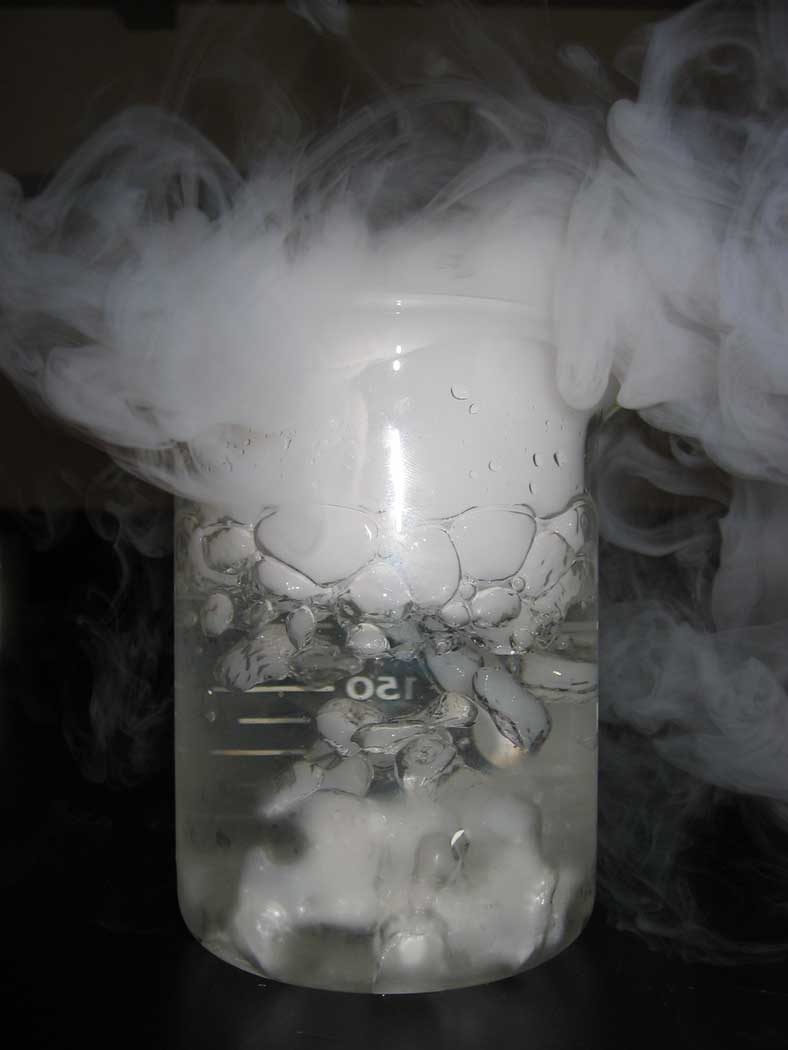Rapid sublimation of "dry ice" in hot water
 The phase transition of "dry ice" is observed in a hot water bath. The system evolves over time, exhibiting a number of interesting changes.
The phase transition of "dry ice" is observed in a hot water bath. The system evolves over time, exhibiting a number of interesting changes.
Ingredients: dry ice, hot water
Procedure: A complete recipe follows.
1. Place dry ice in a beaker and add hot water.
2. Observe the system over time.
Understanding: We call solid carbon dioxide dry ice. In the range of pressures that we live in, all close to one atmosphere, when solid carbon dioxide is heated it does not melt to form a liquid and then vaporize to form a gas. It sublimates from a solid directly to a gas. We never have a chance to observe liquid carbon dioxide, and so the ice is never wet. It is always dry ice.
Examining our beaker carefully, we observe three phases of matter of water and two phases of matter of carbon dioxide. The carbon dioxide appears as solid dry ice and as gas bubbles rising from the beaker.
CO2(s) → CO2(g)
 Water appears as solid in the wet ice forming on the outside of the solid dry ice. It appears as a liquid in the beaker and the gas phase of water is also indirectly visible in the cloud that forms above the hot water of the beaker.
Water appears as solid in the wet ice forming on the outside of the solid dry ice. It appears as a liquid in the beaker and the gas phase of water is also indirectly visible in the cloud that forms above the hot water of the beaker.
The dry ice in our beaker is at the normal temperature of sublimation -78.5C (-109.3F) - the temperature at which the solid and gaseous forms of carbon dioxide coexist at equilibrium at one atomosphere of external pressure. As the solid is heated, the two phases continue to coexist at the temperature of sublimation until all of the solid is converted to gas.
Of course, our system is not at equilibrium. It is rapidly changing in time. Nevertheless, the temperature of the dry ice will not rise above its sublimation temperature. All of the energy transferred as heat from the hot water to the cold dry ice will be used to change the phase of the dry ice from solid to gas at the constant temperature of sublimation. That is one of the most interesting aspects of phases changes, and one that is not always intuitive.
Initially, the dry ice contacts the hot water and sublimates rapidly. A thick white "smoke" pours out of the beaker. Of course, it isn't smoke, but this phase change is often used on stage sets as a cold smoke. It is heavier than air, falling down the sides of the beaker, over the table, and toward the floor. As time passes, the water continues to transfer heat to the dry ice, and the water cools. A coating of wet water ice forms around the remaining dry ice. The white "gas" no longer rises above the beaker. Finally, for a moment gas bubble cease to rise. And then, pop!
Making sense of the "smoke" and the "pop"
Question: As the carbon dioxide gas bubbles are produced, we observe a white and heavy gas pouring out of the beaker. Is it carbon dioxide that we see? We recall that carbon dioxide that we breath out of our mouths is "invisible" in a warm and dry atmosphere. What about on a cold and moist day? Describe the identity of the white and heavy gas.As the system settles, the beaker emits a high pitched whistle. The pitch of the sound grows higher and higher until we hear a loud pop! What is the origin of the high pitched whistle? What occurs in the beaker to create the pop?